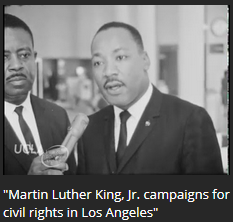Tag: Los Angeles
Primary Sources: UCLA KTLA News Project

According to the press release, “The curated news segments document local, national and international issues, covering politics, economics, civil rights and women’s activism, as well as African-American, Asian-American, Mexican-American, Native American and LGBT communities. Additional news stories on an expanded range of topics will be added to the portal on a periodic basis.”
Ed Ruscha: A New Oral History with the Artist
In partnership with the Getty Trust, we are pleased to release a new oral history with the famed artist Ed Ruscha. Ruscha is an American artist who has specialized in painting, drawing, photography, and books. Born in 1937, Ruscha moved to Los Angeles to attend school at Chouinard Art Institute in 1956. In the early 1960s, he contributed to the birth of “pop art” and his work was featured in the famed 1962 exhibition “New Painting of Common Objects.” In the 1960s, he painted canvases that have since become iconic, including Large Trademark with Eight Spotlights (1961), Standard Station (1963), and Los Angeles County Museum of Art on Fire (1965?68). A signature of his work has been the use of words and phrases, such as in the paintings Optics (1967), Brave Men Run In My Family (1988), and many more. Ruscha also produced an influential series of books based on his photography of the built landscape of Los Angeles, and his continues to document vernacular Los Angeles through photography to this day. He was represented by the Leo Castelli Gallery beginning in the 1970s and then moved to the Gagosian Gallery, which continues to show the artist today. In this interview, Ruscha discusses his art education and influences and his introduction to the burgeoning art world of 1960s Los Angeles. He reflects on the transformation of art after the 1960s with the rise of conceptual and political art and his continuing interest in painting during that era. Finally, Ruscha discusses changes in the art world in the 1980s and 1990s, retrospective exhibitions of his art, the transformation of Los Angeles, and how artists might think about their legacy.